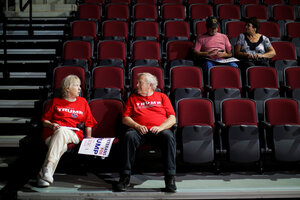When asked to explain partisanship, Americans point to fear
Political animosity between Republicans and Democrats is at a record high in 2016. And with less interaction in both ideology and society, the majority of voters now fear one another.

Audience members wait for a campaign rally with US Republican presidential candidate Donald Trump in Bangor, Maine, Wednesday.
Brian Snyder/Reuters
Michelle Ayala sees 2016 as a crucial election, but has given up having political conversations with Democrats because, she says, “names start flying” if she tries to explain her support for Trump.
"I’m called a racist because I’m a Republican, but they don’t even know that I have a second generation Mexican-American daughter," says Ms. Ayala, a Republican from California. "I definitely identify more with like-minded people in my daily life. It’s easier to be friends with Republicans and I find that sad.”
Her experience is increasingly common – for voters on both sides. Republicans and Democrats feel more animosity toward one another in 2016 than ever in the history of such Pew Research surveys, the latest of which was released last week.
The trend is driven more by fear than anger, with voters increasingly rooting for one party in order to reject a group they perceive as dangerous – a growing phenomenon called "negative partisanship." The unpopularity of Hillary Clinton and Donald Trump is seen as an example of the trend.
And just as the ideological wall is growing taller in Washington, the same divide is being manifested in suburban America as Republicans and Democrats choose to interact with one another less and less, allowing stereotypes to flourish.
“For one, the parties have become more distinct. There used to be more conservative Democrats or liberal Republicans, so losing control wasn’t as big of a deal as it is today,” says John Fortier, director of the Democracy Project at the Bipartisan Policy Center in Washington. “Secondly, there is a clustering of people with like views. People are associating more with their own types, so there is less knowledge and less connection.”
In one example of the fear inspired by the other side, students at Emory University protested in March after some wrote "Trump 2016" and "Accept the Inevitable: Trump 2016" in chalk on campus sidewalks. The Emory Latino Student Organization protested the act in a Facebook post, saying, "They did not do this merely to support the presidential candidate, but to promote the hate and discrimination that goes along with him."
‘The other party seems more alien’
Two political scientists from the University of California, Berkeley, released a study on Republican and Democratic stereotypes in May, reaffirming Americans’ misconceptions of party demographics. Democrats see Republicans as wealthy, older Evangelicals, and Republicans see Democrats as LGBT union members – even though these demographics represent minorities of both parties.
“It’s a rationalization of ‘The in group is good and the out group is bad.’ You develop a negative stereotype and then just fill in the blanks,” says Shanto Iyengar, a professor at Stanford University.
These partisan stereotypes, no matter how unfounded, affect whom Americans want as neighbors. About 40 percent of both Republicans and Democrats say it would be easier to befriend a new community member if he or she were from the same party. And according to a study released by Stanford last year, the desirability of a neighborhood can shift by 20 percent for homeowners depending on their neighbors' political affiliation.
“Marriages, neighborhoods, churches – more of the same people are associating with each other than ever before,” adds Dr. Fortier. “The other party seems more alien…. There is much more self-selection.”
‘With us or against us’ mentality
Today, 58 percent of Republicans have a "very unfavorable" view of the Democratic Party and 55 percent of Democrats feel the same way about the GOP – the highest levels since Pew began polling in 1992, with a particularly significant increase since the 2008 election.
When President Obama was first ushered into office, only about one‐third of Republicans and 37 percent of Democrats held such views of the other party.
This dislike in some cases affects voters' choice more than the appeal of their own party, according to Pew. For example, when asked why they identify as Republican, 68 percent of Republicans cited the fact that Democratic policies are bad for the country as a major reason, while only 64 percent cited confidence in Republican policies.
The polarization of news sources parallels – and likely contributes to – this partisan antipathy. “The standard point and counterpoint is no longer the case," says Dr. Iyengar of Stanford, an expert on politics and public opinion.
“People get their news through 140 characters on Twitter,” says Joe Paru, secretary of Massachsetts Young Republicans.
As the media reinforce Republicans' and Democrats’ stereotypes of each other, that feeds their fear. Half of all Republicans and 55 percent of Democrats say the opposing party makes them feel afraid. Among those highly engaged with politics, these figures jump to 62 and 70 percent respectively.
“It’s a ‘with us or against us’ mentality, and that’s scary,” says Alex Steed, co-owner of a media production business in Maine.
As a Democrat from a conservative town, he sees himself as somewhat of an anomaly, forced to socialize with people of the opposing political party. And that requires a certain civility that increasingly seems lacking.
“Some things are only easy to say if you are never around people who don’t agree with you," says Mr. Steed.

